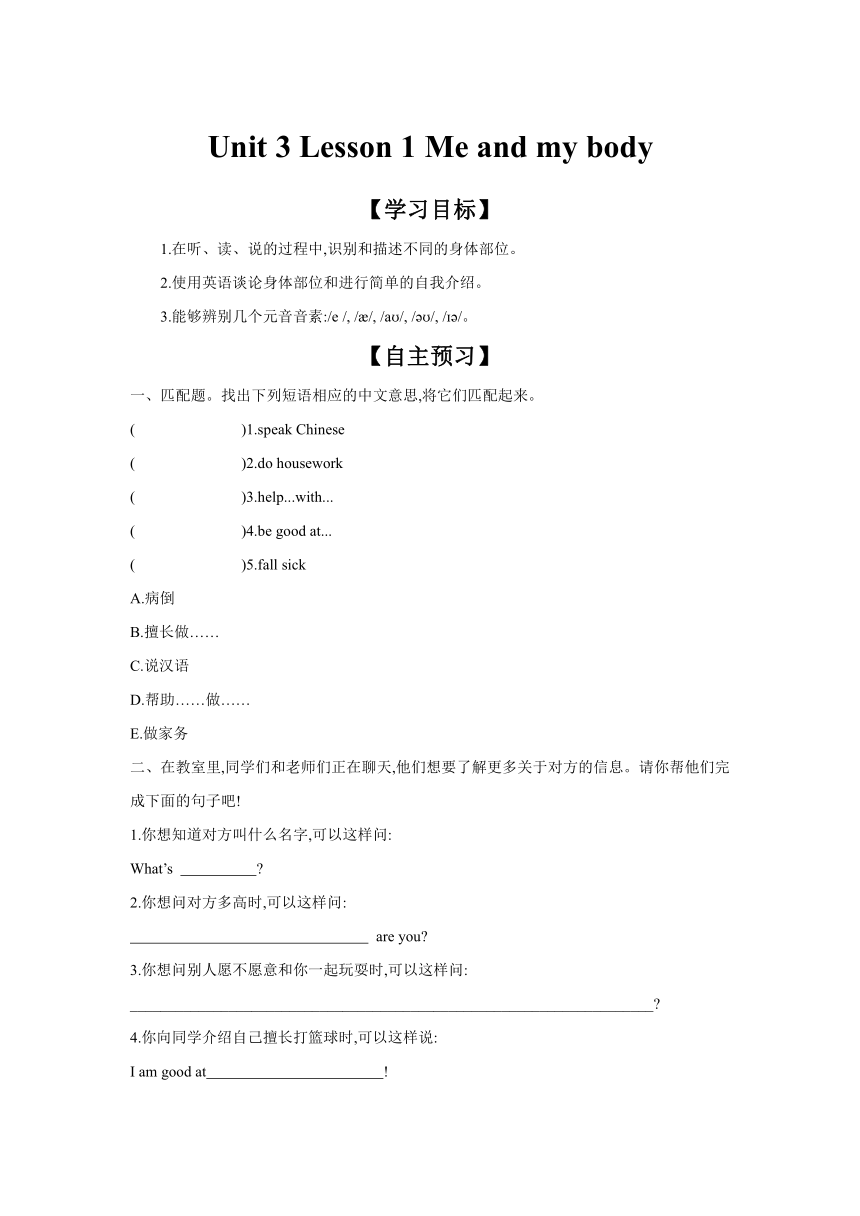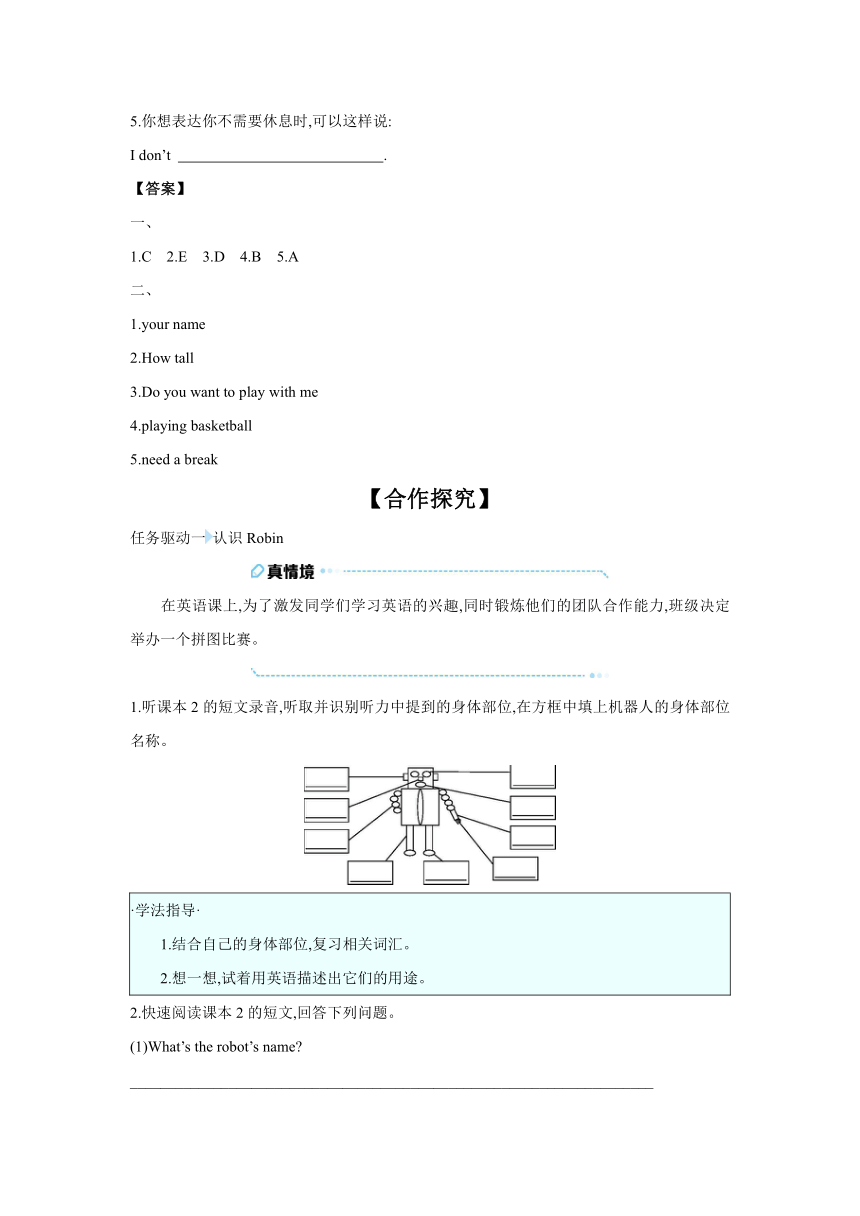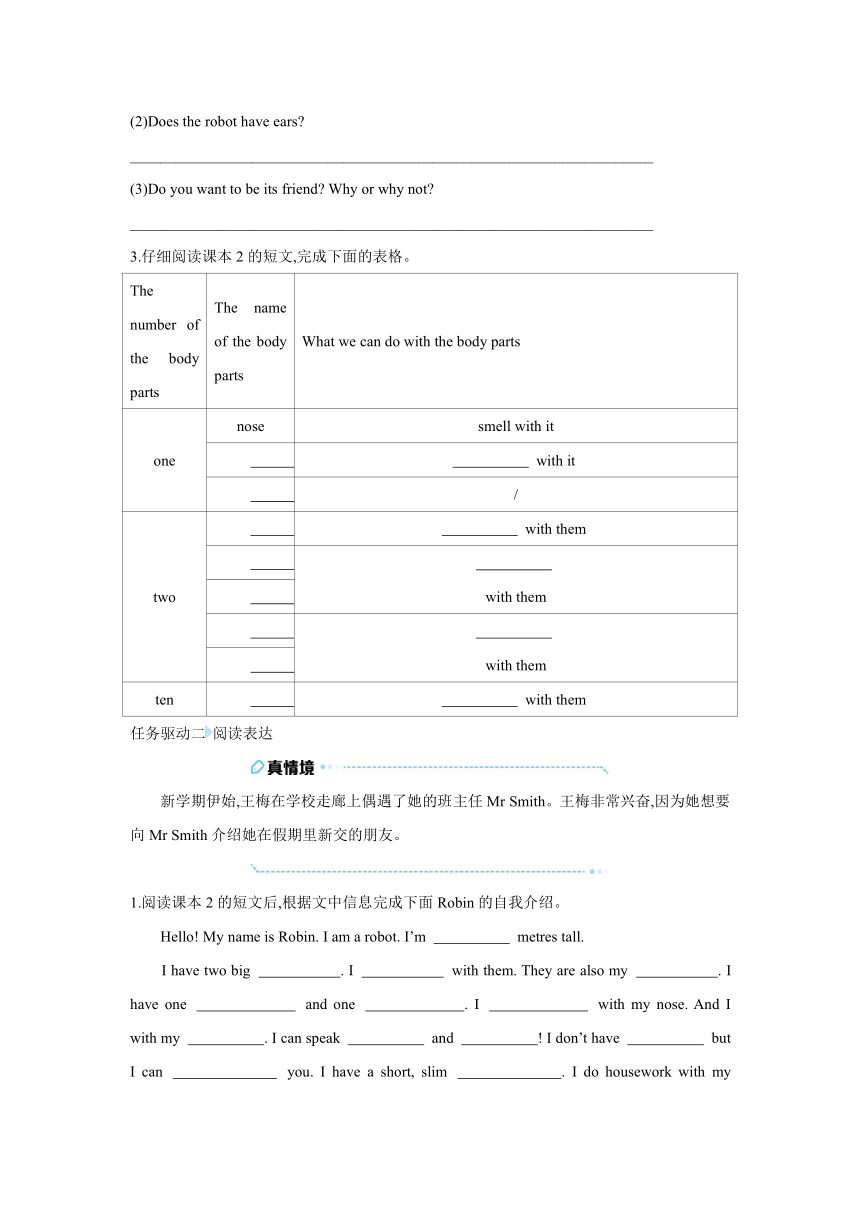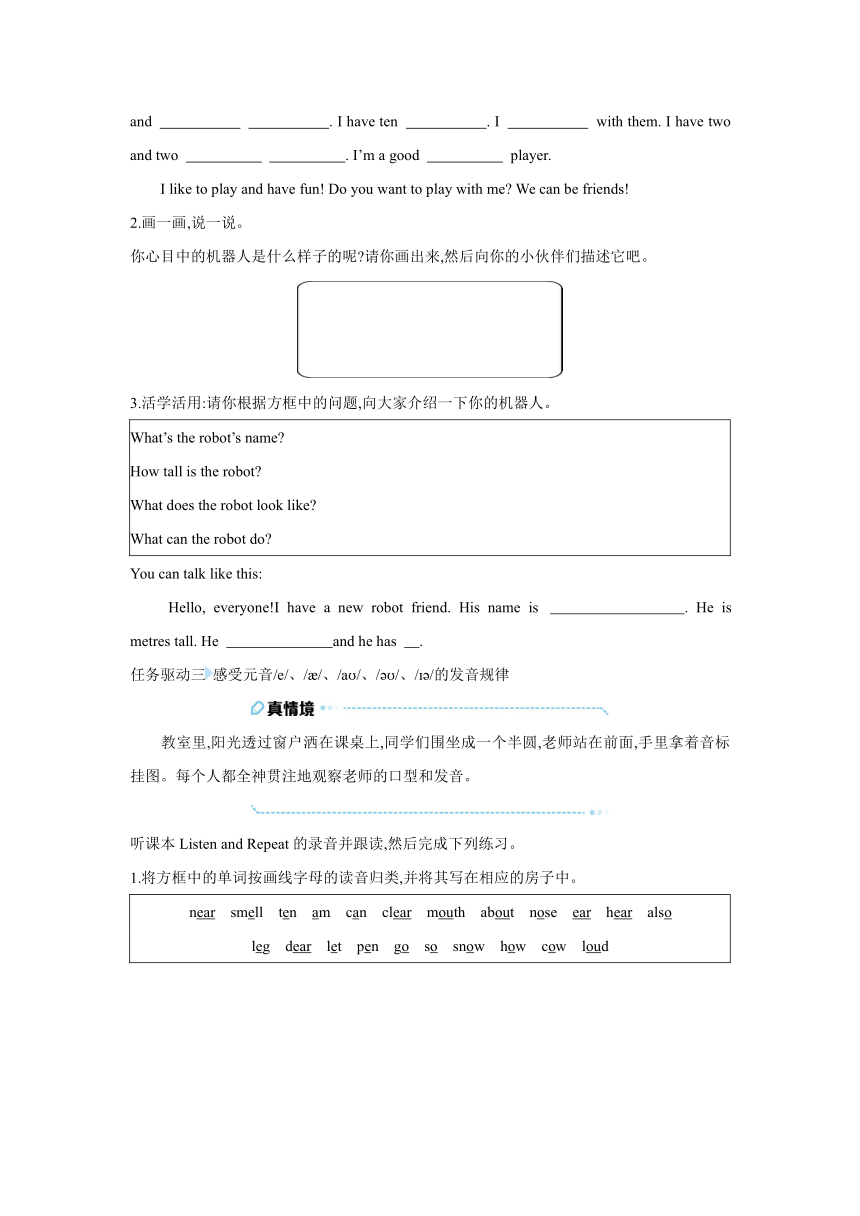【学习任务单】Unit 3 Lesson 1 Me and my body (含答案) 2024-2025学年英语冀教版七年级上册
文档属性
| 名称 | 【学习任务单】Unit 3 Lesson 1 Me and my body (含答案) 2024-2025学年英语冀教版七年级上册 |  | |
| 格式 | docx | ||
| 文件大小 | 129.5KB | ||
| 资源类型 | 教案 | ||
| 版本资源 | 冀教版 | ||
| 科目 | 英语 | ||
| 更新时间 | 2024-12-26 20:14:36 | ||
图片预览




文档简介
Unit 3 Lesson 1 Me and my body
【学习目标】
1.在听、读、说的过程中,识别和描述不同的身体部位。
2.使用英语谈论身体部位和进行简单的自我介绍。
3.能够辨别几个元音音素:/e /, / /, /a /, / /, / /。
【自主预习】
一、匹配题。找出下列短语相应的中文意思,将它们匹配起来。
( )1.speak Chinese
( )2.do housework
( )3.help...with...
( )4.be good at...
( )5.fall sick
A.病倒
B.擅长做……
C.说汉语
D.帮助……做……
E.做家务
二、在教室里,同学们和老师们正在聊天,他们想要了解更多关于对方的信息。请你帮他们完成下面的句子吧!
1.你想知道对方叫什么名字,可以这样问:
What’s
2.你想问对方多高时,可以这样问:
are you
3.你想问别人愿不愿意和你一起玩耍时,可以这样问:
_____________________________________________________________________
4.你向同学介绍自己擅长打篮球时,可以这样说:
I am good at !
5.你想表达你不需要休息时,可以这样说:
I don’t .
【答案】
一、
1.C 2.E 3.D 4.B 5.A
二、
1.your name
2.How tall
3.Do you want to play with me
4.playing basketball
5.need a break
【合作探究】
任务驱动一认识Robin
在英语课上,为了激发同学们学习英语的兴趣,同时锻炼他们的团队合作能力,班级决定举办一个拼图比赛。
1.听课本2的短文录音,听取并识别听力中提到的身体部位,在方框中填上机器人的身体部位名称。
·学法指导·
1.结合自己的身体部位,复习相关词汇。
2.想一想,试着用英语描述出它们的用途。
2.快速阅读课本2的短文,回答下列问题。
(1)What’s the robot’s name
_____________________________________________________________________
(2)Does the robot have ears
_____________________________________________________________________
(3)Do you want to be its friend Why or why not
_____________________________________________________________________
3.仔细阅读课本2的短文,完成下面的表格。
The number of the body parts The name of the body parts What we can do with the body parts
one nose smell with it
with it
/
two with them
with them
with them
ten with them
任务驱动二阅读表达
新学期伊始,王梅在学校走廊上偶遇了她的班主任Mr Smith。王梅非常兴奋,因为她想要向Mr Smith介绍她在假期里新交的朋友。
1.阅读课本2的短文后,根据文中信息完成下面Robin的自我介绍。
Hello! My name is Robin. I am a robot. I’m metres tall.
I have two big . I with them. They are also my . I have one and one . I with my nose. And I with my . I can speak and ! I don’t have but I can you. I have a short, slim . I do housework with my and . I have ten . I with them. I have two and two . I’m a good player.
I like to play and have fun! Do you want to play with me We can be friends!
2.画一画,说一说。
你心目中的机器人是什么样子的呢 请你画出来,然后向你的小伙伴们描述它吧。
3.活学活用:请你根据方框中的问题,向大家介绍一下你的机器人。
What’s the robot’s name
How tall is the robot
What does the robot look like
What can the robot do
You can talk like this:
Hello, everyone!I have a new robot friend. His name is . He is metres tall. He and he has .
任务驱动三感受元音/e/、/ /、/a /、/ /、/ /的发音规律
教室里,阳光透过窗户洒在课桌上,同学们围坐成一个半圆,老师站在前面,手里拿着音标挂图。每个人都全神贯注地观察老师的口型和发音。
听课本Listen and Repeat的录音并跟读,然后完成下列练习。
1.将方框中的单词按画线字母的读音归类,并将其写在相应的房子中。
near smell ten am can clear mouth about nose ear hear also
leg dear let pen go so snow how cow loud
2.判断下列每组单词画线部分读音是(T)否(F)相同。
( )(1)go no so snow
( )(2)cat bag pen smell
( )(3)what wake travel space
( )(4)ear hear tea really
【答案】
任务驱动一
1.
2.(1)Its name is Robin./Robin is its name.
(2)No, it doesn't. But it can hear us.
(3)Yes, I do. Because it is very cute./No, I don't. Because it doesn't have feelings.
3.mouth talk neck eyes see arms do housework
hands legs play football feet fingers write
任务驱动二
1.1.65 eyes see cameras nose mouth smell talk mouth English Chinese ears hear neck
long arms small hands fingers write long legs big feet football
任务驱动三
1.
2.(1)T (2)F (3)F (4)F
【知识超市】
I have two big eyes. 我有两只大眼睛。
have作实义动词, 意为“有;拥有”,它的第三人称单数形式是has。它强调某个东西归某人所有,也可用于形容某人的外貌特征,尤其是五官及头发。常用句型:sb.+have/has +(a/an)形容词+名词。例如:
She has two big eyes. 她有两只大眼睛。
知识拓展 其否定结构为:sb.+don’t/doesn’t have+(a/an)形容词+名词。当主语是第三人称单数时,肯定句用has,否定句用doesn’t have。
素养训练 用have或has填空。
1.I two sisters.They are very beautiful.
2.Tom and Jane a big house in the city.
3.Lily a pair of purple gloves.
4.He long legs and a small nose.
【答案】
1.have 2.have 3.has 4.has
I see with them. 我用它们看。
该句中的with作介词,意为“用……”,表示方式, 在句中作状语,后常跟身体部位或者工具。
知识拓展 with还意为“和……一起”,表示伴随,在句中作状语。例如:
He often sleeps with the windows open.他常开着窗睡觉。
素养训练 选词填空。
1.Look! The boy can write his left hand. (to, for, with, in)
2.Tom can make a plane paper. (to, for, with, in)
3.Please come me! (to, for, with, in)
【答案】
1.with 2.with 3.with
They are also my cameras.它们也是我的照相机。
also作副词,意为“也”,用于实义动词之前,系动词或助动词之后。同义词too 需放在句尾。例如:
I also get to school early every day. = I get to school early every day, too. 我也每天很早到校。
素养训练 选词填空。
1.He is an American student. (too, also)
2.I want to go shopping with you, .(too, also)
【答案】
1.also 2.too
I smell with my nose. 我用鼻子闻。
smell意为“闻;嗅”。例如:
What can you smell 你能闻到什么
知识拓展
1.smell 还可作连系动词,意为“闻起来”,后接形容词作表语。例如:
The flowers smell good. 花闻起来很香。
2.smell还可以作名词,意为“气味”。例如:
What a nice smell! 多香的味道啊!
素养训练 根据汉语意思完成句子,每空一词。
1.你能用鼻子闻一下吗
Can you your nose
2.那些玫瑰好闻极了。
Those roses good.
【答案】
1.smell with
2.smell
Do you want to play with me 你想和我一起玩吗
用法总结 一般疑问句中,如果主语为第三人称单数(he、she、it),需借助does,再加实义动词原形;如果是其他人称,需借助do,再加上实义动词原形。
Do / Does +主语 +实义动词原形 + 其他
Does Sandy watch TV every night Sandy每晚看电视吗
肯定回答:
当主语为第三人称单数时:Yes, 主语+does.
当主语为其他人称时:Yes, 主语+do.
否定回答:
当主语为第三人称单数时:No, 主语+doesn’t.
当主语为其他人称时:No, 主语+don’t.
知识拓展 当谓语动词或助动词是be, can, may, must等时,一般现在时的一般疑问句则将这些词移到主语前面,而它们后面的部分通常保持不变。例如:
Are you students Yes, we are./ No,we aren’t. 你们是学生吗 是的,我们是学生。/ 不,我们不是。
温馨提示 改为一般疑问句时,原句中的第一人称改为第二人称;原句中的some改为any。
素养训练 根据汉语意思完成句子。
1.你每天六点起床吗
get up at six o’clock every day
2.他经常骑自行车上学吗
often go to school by bike
3.你的妈妈会说英语吗
English
【答案】
1.Do you
2.Does he
3.Can your mother speak
【学习目标】
1.在听、读、说的过程中,识别和描述不同的身体部位。
2.使用英语谈论身体部位和进行简单的自我介绍。
3.能够辨别几个元音音素:/e /, / /, /a /, / /, / /。
【自主预习】
一、匹配题。找出下列短语相应的中文意思,将它们匹配起来。
( )1.speak Chinese
( )2.do housework
( )3.help...with...
( )4.be good at...
( )5.fall sick
A.病倒
B.擅长做……
C.说汉语
D.帮助……做……
E.做家务
二、在教室里,同学们和老师们正在聊天,他们想要了解更多关于对方的信息。请你帮他们完成下面的句子吧!
1.你想知道对方叫什么名字,可以这样问:
What’s
2.你想问对方多高时,可以这样问:
are you
3.你想问别人愿不愿意和你一起玩耍时,可以这样问:
_____________________________________________________________________
4.你向同学介绍自己擅长打篮球时,可以这样说:
I am good at !
5.你想表达你不需要休息时,可以这样说:
I don’t .
【答案】
一、
1.C 2.E 3.D 4.B 5.A
二、
1.your name
2.How tall
3.Do you want to play with me
4.playing basketball
5.need a break
【合作探究】
任务驱动一认识Robin
在英语课上,为了激发同学们学习英语的兴趣,同时锻炼他们的团队合作能力,班级决定举办一个拼图比赛。
1.听课本2的短文录音,听取并识别听力中提到的身体部位,在方框中填上机器人的身体部位名称。
·学法指导·
1.结合自己的身体部位,复习相关词汇。
2.想一想,试着用英语描述出它们的用途。
2.快速阅读课本2的短文,回答下列问题。
(1)What’s the robot’s name
_____________________________________________________________________
(2)Does the robot have ears
_____________________________________________________________________
(3)Do you want to be its friend Why or why not
_____________________________________________________________________
3.仔细阅读课本2的短文,完成下面的表格。
The number of the body parts The name of the body parts What we can do with the body parts
one nose smell with it
with it
/
two with them
with them
with them
ten with them
任务驱动二阅读表达
新学期伊始,王梅在学校走廊上偶遇了她的班主任Mr Smith。王梅非常兴奋,因为她想要向Mr Smith介绍她在假期里新交的朋友。
1.阅读课本2的短文后,根据文中信息完成下面Robin的自我介绍。
Hello! My name is Robin. I am a robot. I’m metres tall.
I have two big . I with them. They are also my . I have one and one . I with my nose. And I with my . I can speak and ! I don’t have but I can you. I have a short, slim . I do housework with my and . I have ten . I with them. I have two and two . I’m a good player.
I like to play and have fun! Do you want to play with me We can be friends!
2.画一画,说一说。
你心目中的机器人是什么样子的呢 请你画出来,然后向你的小伙伴们描述它吧。
3.活学活用:请你根据方框中的问题,向大家介绍一下你的机器人。
What’s the robot’s name
How tall is the robot
What does the robot look like
What can the robot do
You can talk like this:
Hello, everyone!I have a new robot friend. His name is . He is metres tall. He and he has .
任务驱动三感受元音/e/、/ /、/a /、/ /、/ /的发音规律
教室里,阳光透过窗户洒在课桌上,同学们围坐成一个半圆,老师站在前面,手里拿着音标挂图。每个人都全神贯注地观察老师的口型和发音。
听课本Listen and Repeat的录音并跟读,然后完成下列练习。
1.将方框中的单词按画线字母的读音归类,并将其写在相应的房子中。
near smell ten am can clear mouth about nose ear hear also
leg dear let pen go so snow how cow loud
2.判断下列每组单词画线部分读音是(T)否(F)相同。
( )(1)go no so snow
( )(2)cat bag pen smell
( )(3)what wake travel space
( )(4)ear hear tea really
【答案】
任务驱动一
1.
2.(1)Its name is Robin./Robin is its name.
(2)No, it doesn't. But it can hear us.
(3)Yes, I do. Because it is very cute./No, I don't. Because it doesn't have feelings.
3.mouth talk neck eyes see arms do housework
hands legs play football feet fingers write
任务驱动二
1.1.65 eyes see cameras nose mouth smell talk mouth English Chinese ears hear neck
long arms small hands fingers write long legs big feet football
任务驱动三
1.
2.(1)T (2)F (3)F (4)F
【知识超市】
I have two big eyes. 我有两只大眼睛。
have作实义动词, 意为“有;拥有”,它的第三人称单数形式是has。它强调某个东西归某人所有,也可用于形容某人的外貌特征,尤其是五官及头发。常用句型:sb.+have/has +(a/an)形容词+名词。例如:
She has two big eyes. 她有两只大眼睛。
知识拓展 其否定结构为:sb.+don’t/doesn’t have+(a/an)形容词+名词。当主语是第三人称单数时,肯定句用has,否定句用doesn’t have。
素养训练 用have或has填空。
1.I two sisters.They are very beautiful.
2.Tom and Jane a big house in the city.
3.Lily a pair of purple gloves.
4.He long legs and a small nose.
【答案】
1.have 2.have 3.has 4.has
I see with them. 我用它们看。
该句中的with作介词,意为“用……”,表示方式, 在句中作状语,后常跟身体部位或者工具。
知识拓展 with还意为“和……一起”,表示伴随,在句中作状语。例如:
He often sleeps with the windows open.他常开着窗睡觉。
素养训练 选词填空。
1.Look! The boy can write his left hand. (to, for, with, in)
2.Tom can make a plane paper. (to, for, with, in)
3.Please come me! (to, for, with, in)
【答案】
1.with 2.with 3.with
They are also my cameras.它们也是我的照相机。
also作副词,意为“也”,用于实义动词之前,系动词或助动词之后。同义词too 需放在句尾。例如:
I also get to school early every day. = I get to school early every day, too. 我也每天很早到校。
素养训练 选词填空。
1.He is an American student. (too, also)
2.I want to go shopping with you, .(too, also)
【答案】
1.also 2.too
I smell with my nose. 我用鼻子闻。
smell意为“闻;嗅”。例如:
What can you smell 你能闻到什么
知识拓展
1.smell 还可作连系动词,意为“闻起来”,后接形容词作表语。例如:
The flowers smell good. 花闻起来很香。
2.smell还可以作名词,意为“气味”。例如:
What a nice smell! 多香的味道啊!
素养训练 根据汉语意思完成句子,每空一词。
1.你能用鼻子闻一下吗
Can you your nose
2.那些玫瑰好闻极了。
Those roses good.
【答案】
1.smell with
2.smell
Do you want to play with me 你想和我一起玩吗
用法总结 一般疑问句中,如果主语为第三人称单数(he、she、it),需借助does,再加实义动词原形;如果是其他人称,需借助do,再加上实义动词原形。
Do / Does +主语 +实义动词原形 + 其他
Does Sandy watch TV every night Sandy每晚看电视吗
肯定回答:
当主语为第三人称单数时:Yes, 主语+does.
当主语为其他人称时:Yes, 主语+do.
否定回答:
当主语为第三人称单数时:No, 主语+doesn’t.
当主语为其他人称时:No, 主语+don’t.
知识拓展 当谓语动词或助动词是be, can, may, must等时,一般现在时的一般疑问句则将这些词移到主语前面,而它们后面的部分通常保持不变。例如:
Are you students Yes, we are./ No,we aren’t. 你们是学生吗 是的,我们是学生。/ 不,我们不是。
温馨提示 改为一般疑问句时,原句中的第一人称改为第二人称;原句中的some改为any。
素养训练 根据汉语意思完成句子。
1.你每天六点起床吗
get up at six o’clock every day
2.他经常骑自行车上学吗
often go to school by bike
3.你的妈妈会说英语吗
English
【答案】
1.Do you
2.Does he
3.Can your mother speak
同课章节目录
